I was struggling to grow a proper sourdough starter for about a year and a half. When my bread got moldy it was always the same - the mold was fuzzy/hairy and it smelled like whitewash (the final white layer on plaster). Moldy bread baked from commercial (dry) yeast also had the same smell. If I put my bread into a plastic bag - even with the bag fully open so the bread was in contact only at the bottom - it would get this fuzzy mold in 2 days. But only on the side where it couldn't breath (where it was touching the bag). Leaving it in the oven on the rack was fine, no mold for 4-5 days. I was religiously following the "wait until the peak starts falling, then feed" starter feeding routine. The rise was good, the smell was mild. If I fed wholegrain flour it got the smell of rotten eggs. If I fed white flour that smell wasn't present so I continued with white (for the record, I started a second starter when feeding wholegrain to keep my "good" white starter intact).
About two months ago I neglected my feeding routine and it started to smell sour. The thing is, I have never tasted, smelled or seen anyone else's sourdough but mine so I am not sure how exactly it should behave. Now I would like to confirm whether my starter has become a proper sourdough starter or not (is it still a wild-culture starter?).
I baked a loaf of bread from white flour T500 (the whitest flour is 400, bread flour is 850), waited about 12 hours so it was cool to the touch. I sliced off a chunk of bread and put it in a plastic bag, wrapped around it so it had minimal to no air circulation (to promote mold).
PS: press your mouse-wheel to open pictures in new tab
18th of November, wrapped:
[URL=http://s1279.photobucket.com/user/Roost12/media/wrap_zpsddf44c74.jpg.html]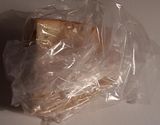 [/URL](click image for larger version)
[/URL](click image for larger version)
21st of November, the first (white) mold was visible:
[URL=http://s1279.photobucket.com/user/Roost12/media/21_zpsc41d8118.jpg.html]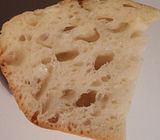 [/URL](click image for larger version)
[/URL](click image for larger version)
24th of November, the first blue-green mold was visible:
[URL=http://s1279.photobucket.com/user/Roost12/media/24_naturallight_zps9f75ad52.jpg.html]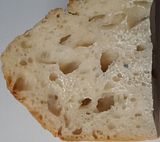 [/URL]Natural light (click image for larger version)
[/URL]Natural light (click image for larger version)
[URL=http://s1279.photobucket.com/user/Roost12/media/24_artificiallight_zps88899c19.jpg.html]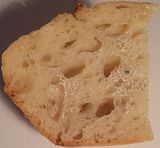 [/URL]Artificial light (click image for larger version)
[/URL]Artificial light (click image for larger version)
[URL=http://s1279.photobucket.com/user/Roost12/media/24_zoom_zps425773da.jpg.html]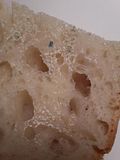 [/URL]Zoomed in (click image for larger version)
[/URL]Zoomed in (click image for larger version)
25th of November, mold is more pronounced:
[URL=http://s1279.photobucket.com/user/Roost12/media/25_topdown_zps166cf346.jpg.html]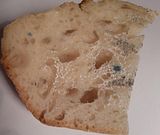 [/URL]You can see 3 different molds (click image for larger version)
[/URL]You can see 3 different molds (click image for larger version)
[URL=http://s1279.photobucket.com/user/Roost12/media/25_texture_zps21e40454.jpg.html]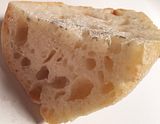 [/URL]And different angle to see molds' texture (it's not fuzzy)(click image for larger version)
[/URL]And different angle to see molds' texture (it's not fuzzy)(click image for larger version)
Oh I almost forgot. This new mold doesn't smell at all. I could almost say it has no smell but it's so faint I can't describe it. I smelled it right now (27th of November...the mold is MUCH more pronounced than on 25th) and the aroma hasn't changed. Maybe it reminds of moldy bread baked from commercial fresh yeast...but I can't be sure. I suspect the blue-green mold is the one giving off that smell but even if it is, it's still a different mold because this one is super faint while the one from commercial yeast is super smelly.
So what do you think, is my starter a sourdough starter yet or is it still a wild-culture?
Eat it, don't wrap it.
Seriously - you can wait 12 hours before slicing it? I can barely wait 5 minutes if I'm being really good when I've baked a loaf for myself. And keeping it for a week? Nope. Gone in a few days. I keep my bread in a cloth bag. Goes stale after a few days, but then it goes into the toaster.
Also, if your starter and technique can make bread that looks like that, then I'd suggest it's doing just fine.
Here's a question: What did it taste like when you first sliced into it?
If it looks like bread, smells like bread and tastes like bread then it must be ....
Bake, eat, enjoy.
And if you can't eat it all, slice it and freeze it.
-Gordon
Once the bread has been baked it is pretty much sterilized so if you are having a mold problem the spores are not coming from your sourdough culture.
Gerhard
The mold problem I guess has to do with that plastic wrap and condensation in it.
I never wrap my bread, mine stays on my wooden cutting board and is fine for a few days before it gets stale, but mind you, it is usually gone before it even has a chance to become stale lol.
I have to bake every day since we are a family of 6 and bread lovers.
You guys and girls make it sound like your sourdough never gets moldy. :)
Baking doesn't sterilize the bread. Some cultures survive. Not every mold is bad. When the "good guys" flourish long enough they can be seen by the naked eye. That's what mold is...overgrown cultures that spread so much they can be seen. The best preservative are "good" cultures. Antibiotic cleaners just kill the good guys and leave bad ones to dominate.
Regarding the taste, I would say it's ok. My white sourdough bread doesn't have a lot of flavour. It tastes like pretzels (not the German kind, but those where you first boil the dough and then bake). The bread baked from that "fuzzy" starter was laxative if I ate it fresh from the oven. This starter now doesn't have that problem so it's ok-ish.
But....keeping in mind what I have read learnt from you guys and girls, I have the impression my starter should smell sour when it peaks. That (still) doesn't happen. Instead, I need to wait until it fully collapses and only then it smells sour. Right now it goes through these stages:
If I fed it every time it peaked it would lose the sour and went back to the fuzzy/hairy culture (so no sour smell, just "no smell" and "alcohol"). I haven't tried that, mind you, but that's what I suspect it would happen.
Honestly never had a mold problem, not on my bread * that only goes stale after 4-5 days * nor on my Starter/s.
I do never wrap my bread up in foil, as I said, mine sits on a wooden cutting board with the cut side down to ensure it won't dry out.
Sometimes I throw a clean kitchen towel over it, but that is all.
My 100% wheat starter smells just like yours in stages, so it never has * no smell *
When it is starving and you open the lid it really hurts your nose, it burns or feels like someone stabbed you in the nostrill.
You Starter sounds good to me.
it is bread Abe.
Not sure what happened to my text before. hmmm
It's just that the question was about a starter. I don't think bread going mouldy reflects on if one has a proper starter or not. It's all about storage of the bread and how quickly its eaten.
Just a bit confused for a moment.
I was also confused as to why the mold on the bread had anything to do with if the starter was mature, and I was also curious also why one would purposefully induce mold to grow on something as lovely as home made sourdough bread!
I thought as soon as your starter could double in 6-8 hours and make a loaf of bread, it was a starter- ?
As for my starter, sometimes it smells more alcoholy, sometimes more fruity, but honestly as long as it bubbles, and can double in 8 hours or so, and makes a nice loaf, I don't bother with how it smells. I also only feed it right before I bake, usually once a week, sometimes longer. I take my 100 grams or so out of the fridge, feed it with equal weights of water and flour, put 100 gr back in the jar and back in the fridge, and use the rest to make 2 loaves of bread.
Of course, I gave up trying to be a scientist, found a simple recipe and method that produces consistent bread that family gobbles up and friends request and have offered to pay for, and forgone trying to learn how to shape and all the other stuff. Made my head spin. I slap my dough in bread tins, bake covered, for 30 minutes, then uncovered for 20, and get a delightful loaf that fits wonderfully into the bread guide so it can be sliced.
My bread does, on occasion mold, whether it is left out of the bag or in a bag, but usually only during the summer months, when it can happen in as little as 2 days. We put it in the fridge then( i know, I know, but it works for us).
SO anyway, AM i missing something else?
If a doctor wasn't able to come to see your sick child, what could you do? Probably you could do the most by sending some blood samples to the doctor. That way (s)he could gain insight into the situation without physically examining the child. Nothing can really substitute physical examination but a blood sample would be a great start.
I thought mold(y bread) would be a great way to show you my starter without you being physically here. Starter is all about cultures so mold should reflect that. Different bacterial balance, different mold. The white mold on pictures above could be lactobacillus (not likely), blueish-green could be yeast, not sure what the gray could be. I am not expecting detailed balance ratios of various cultures, but just a general "you are in the ballpark" or "doesn't look like mine mold".(that fuzzy/hairy mold looks & smells totally more malicious :)). Heck, I wouldn't know what to do with cultural balance ratios. If they were on paper they could keep me warm. :)
I am a bit skeptical about the white mold being lactobacillus because my bread doesn't get markedly more sour the closer it is to the moldy stage (it gets moldy around day 5 the way I normally store my bread). I know this because a couple of years ago I had some strange starter inoculated with kefir. When bread made from that starter got moldy it was so extremely sour....it was like eating vinegar (different taste but the same tasting strength). So if that white mold was lactobacillus it would taste more SOUR.
Does this make sense at all? If it doesn't, here is what I am trying to achieve: "learn what a proper sourdough starter is like" and how to get there. It may seem like I went about this totally the wrong way but there is really no good alternative. I have been struggling with my starter for almost 2 years now, strictly following proper feeding regime and the starter was floating, raised extremely well....but it wasn't sour and the mold reflected that (fuzzy/hairy bread). Right now I would believe my starter to be a proper sourdough starter if it wasn't for the discrepancy between peaking and souring. I got the impression sourdough should smell sour when it peaks (mine doesn't, see my previous reply).
Ok, I get the feeling this isn't working. If people don't understand me I become more and more detailed in my descriptions which usually doesn't make things any better. Why do I have so many problems with my starter. :/
... that showing us the finished product is really showing us what your starter looks like. When you take it out of the oven, the outside has been exposed to temperatures of 200C or more and the inside is probably at at least 90C - that pretty much renders anything you put inside it dead and sterile (ie. all your yeasts, bacteria are killed by the cooking process), so you're showing us what we know - if you wrap bread up, then after a few days it goes mouldy. It's gone moundy because there are natural spores, moulds, yeasts, etc. in the atmosphere all round us - maybe even in the bag you wrapped it up in (was it recycled, or new?) and these have fallen on the bread which you've kept in a nice damp condition by wrapping it, (and warm too?) so they started to grow. A good strong sourdough in the dough/bread will inhibit the spoilage for a few days without adding any additional preservatives, but it's not perfect. This happens. Bread gets mouldy eventually - unless it completely stales/dries out (then you make toast or bread and butter pudding with it)
Maybe you live in a damp/humid climate? Next to a farm, make lots of beer/cider/vinegar etc. or just have dirty hands? all these will contribute to moulds growing once the bread has cooled down.
Why not do this:
Take 100g of your starter. Add 100g of flour and 100g of water. Mix. Photo. Leave covered for 5-6 hours. Take another photo and show us the photos. Also taste it and smell it.
This:
is what my starter looks like when I've taken it from the fridge and "bulked" it up.
and this:
is what it looks like some 5 hours later.
How does yours compare?
But regardless of this - it looks like your starter can make bread. Try the bread.
-Gordon
A starter is flour and water which has fermented and has become a "petri dish" of yeasts and good bacteria which feed off flour and water, your dough, produce gas which in turn levens your bread. So basically your starter is a medium by which you infect your dough.
If you have a healthy starter it will leven your dough. Which clearly it does.
If your starter is unhealthy it would be incapable of doing its job which is levening.
Once the yeats and bacteria have done their job then they are killed off when baking.
This is why we aren't understanding. Showing us what is clearly a piece of bread, thereby proving your starter works, and then asking us if your bread is going mouldy because of the starter doesn't add up.
I suggest you start a very detailed blog from feeding your starter, preparing a pre-ferment, formation of dough, fermentation process and baking. Include description and photos. Then everyone will get a clearer view of what is going on.
I think once the bread is successfully baked the the starter is out of the picture and it's down to storage and time.
Hope this helps.
No it doesn`t make sense! This is what you`re dealing with and it has no bearing on your starter! http://www.madsci.org/FAQs/micro/molds.html
This thread is too lengthy to slog through, but if your baked, finished bread comes out of the oven OK and then goes moldy, it isn't a starter problem, guaranteed.
I've had two starters die of mold. When I was just starting out I kept the starter at room temperature all the time. I haven't had a mold problem since I started refrigerating it (for weeks and months). If your starter goes moldy, you'll know it. Mine developed black streaks and I poured it all down the drain, then washed the vessel thoroughly with anti-bacterial soap.
Stop right there. That tells me everything I need to know.
Do you have a fabric pouch that you could try keeping this bread in? A porous fabric which will breathe?
Thanks guys and girls. After a search I found my answer in this topic:
http://www.thefreshloaf.com/node/24339/starter-does-not-smell-sour-or-smell-all
Seems like my starter isn't right yet. I will try to feed it twice daily at 100% hydration and a ratio of 1:1:1 as suggested above (I like how the starter feels when I mix that ratio). Unless you suggest a higher ratio? I read higher inoculation makes the culture more stable.
... is you being far too fussy over it...
The starter works. It made what looks like good bread. Make more, eat bread, be happy.
By all means experiment, but I really do not know what you hope to achieve. You've made what looks like good bread. What more do you want?
-Gordon